
PREV ARTICLE
NEXT ARTICLE
FULL ISSUE
PREV FULL ISSUE
JACQUIER AUCTION SALE 39
Björn Schöpe of CoinsWeekly also submitted this preview of the September 2014 Jacquier auction sale 39. Thanks.
-Editor
12 September, 2014
Superb rarities in Jacquier auction sale 39 A selection of superb gems can be found in the catalog of the upcoming auction sale #39 of Paul-Francis Jacquier. The focus is on the Greek east, rare antoniniani and the Gallic Empire. Additionally, the connoisseur discovers two pfennige of Charlemagne from Mainz that are of the utmost rarity. You better mark the following date in your calendar: 12 September 2014, 4 p.m. sharp. This is when the 39th auction sale of Paul-Francis Jacquier starts. Once again he has managed to assemble an extremely attractive offer of rarities for the advanced collector. Almost 1,100 lots of ancient coins, cut gemstones, mobiliary art objects and numismatic literature will be auctioned off. Within the 22 Celtic and 141 Greek coins the aficionado detects numerous pieces that stand out, be it due to their rarity, their historical importance, their appeal, their provenance, or a combination of all of these criteria. The selection of rare fractions and bronzes is particularly broad. The main focus of the material, however, is on another special field that has been cultivated in the house of Jacquier for many years: The Greek east which is represented by 137 lots.
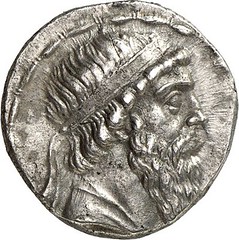
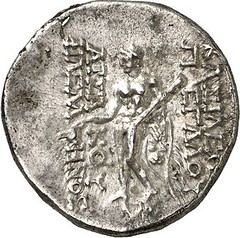
((166 – Mithradates I, 164-132 (Parthians). Tetradrachm, Seleucia on the Tigris, c. 141/40. Sellw. 13. 2. Shore 35. Sunrise 260. Ex Peus 363 (2000), 5104. Very rare. Extremely fine. Estimate: 3,500 euros)) Even he who has dealt with this field for a long time will learn something new in the notes since latest research had its influence on the catalog. Hence, the non-expert soon gets confused by all these names, of peoples, countries and rulers, ones he had never come across so far: Artav and Safshafan of Choresmia, the Paratarajas or Alchan. If you have no clue as to what these terms mean than you should take a look at the catalog. The Empire of the Arsacids – or, as it is also referred to – the Parthian Empire kicks the section off. And the connoisseur discovers rarities like the very rare tetradrachms of Mithradates I (estimate: 3,500 euros) and of Artabanos II (estimate: 4,000 Euro).
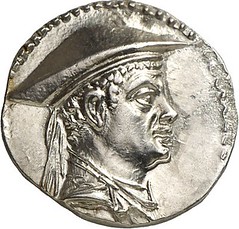
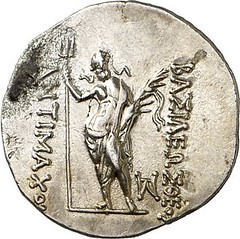
((202 – Antimachos I, 174-165 (Bactria). Attic drachm. Mitchiner 125. Bopearachchi, series 2C. SNG ANS 282. Very rare denomination. Apart from material defect in the reverse good extremely fine. Estimate: 800 euros)) Charakene, Elymais and Persis lead over to Bactria with its gorgeous tetradrachms depicting the monumental portrait heads of its rulers. Agathocles in the name of Euthydemos (VF+, estimate: 3,000 euros), Antimachos I (splendid specimen, estimate: 3,000 euros) or Eucratides I (splendid specimen, estimate: 2,000 euros) are all represented by tetradrachms. Anyone diving deeper into this subject will notice the excellently preserved drachm of Antimachos I which as denomination is significantly rarer than any tetradrachm of this field.
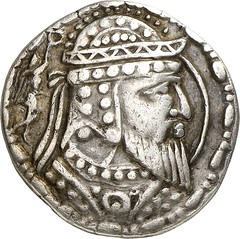
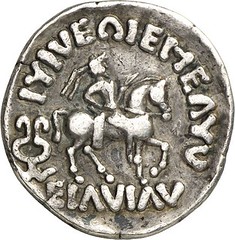
((211 – Artav (Choresmia). Tetradrachm, 1st cent. A. D. Sunrise 517. MIG Type 498. Ex Triton XII (2009), 415. Extremely rare. Good very fine. Estimate: 7,500 euros)) Margiana, Sogdiana, Choresmia – the names of the provinces are getting more exotic by the minute. And it is only very few people that have ever heard of Artav who ruled the last of the aforementioned provinces in the 1st cent. A. D. An extremely rare tetradrachm of this ruler is on offer that ranges stylistically between the Parthian and the Bactrian coinage. The Indo-Scythians, the Kushan Empire, Guptas and of course the Sasanids with many a rarity, covering Ardashir I, Vahram I and Buran – they are all there to find. The section is concluded by a vast selection of Kidarites and coins of the Alchan.
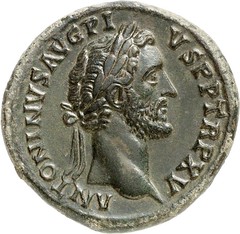
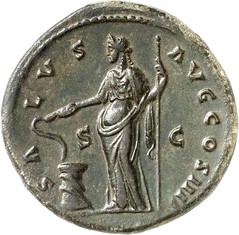
((365 – Antoninus Pius, 138-161. Sestertius, 152. RIC 886. BMCRE 1901. Extremely fine. Estimate: 3,000 euros)) Roman coins are next in line, beginning with the coinage of the Civil Wars, including some portraits of Cesar, and of Marc Antony and Octavian as well. Anyone fond of fine bronzes will be thrilled by the range of offer from Roman Imperial Times. Tesserae from the 1st cent., marvelous sestertii and bronzes of the Greek cities under Roman rule – every single piece was selected with due regard to a fine patina.
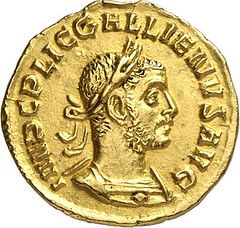
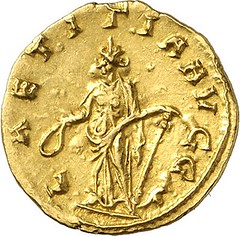
((492 – Gallienus, 253-268. Aureus, 253-254. RIC 79. MIR 46p. Ex Huntington Collection (HSA 30107). Rare. Extremely fine / about extremely fine. Estimate: 10,000 euros)) Customers of Jacquier are well aware of the fact that especially the offer of coins from the second half of the 3rd cent. A. D. beats everything that can be encountered in other auction sales. The aureus of Gallienus from the Huntington Collection, therefore, may be the most expensive item of the section – but to the collector the small series of animal depictions dating to 267/8 is every bit as interesting.
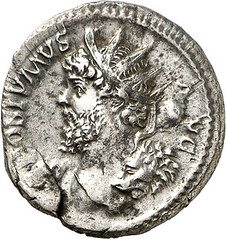
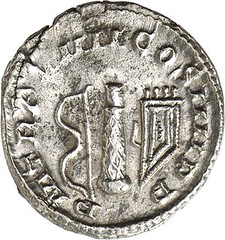
((527 – Postumus, 260-269. Antoninianus, Cologne, 1st half 268. AGK 65b. Elmer 560. Cunetio 2445. Very rare. Extremely fine. Estimate: 3,500 euros)) And of course the rarities from the Gallic Empire represent a bigger part of this auction sale as well. Just think of the rare antoninianus from Cologne that features Postumus with the attributes of Hercules. You will also find a second example of the coin type bearing the first time the name of Cologne like the one that had been sold in auction #38 for 2,400 euros.

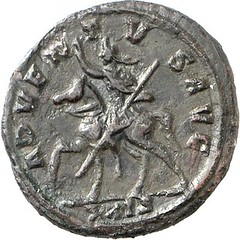
((624 – Probus, 276-282. Antoninianus, Siscia, 277. RIC 627. Ex Roma III (2012), 535. Extremely rare. Extremely fine. Estimate: 2,000 euros)) Outright spectacular is the material assembled under the heading “Special Collection of Rare Antoniniani (268-294)”. The collector had made quite sure about sorting the wheat from the chaff. He who loves special busts is requested to examine the offer with particular care. The emperor with shield and spear, holding the horse by the reins, or in consular garment with trabea and eagle scepter, not to forget heroic nudity: the 122 pieces of this collection provide a good sample of the rarities that are hidden amongst the mass coinage of this era.
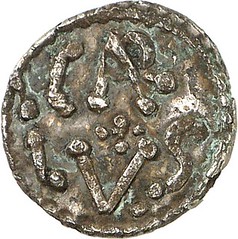
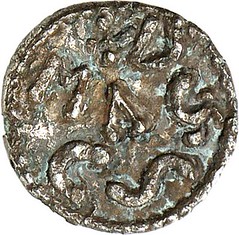
((851 – Charlemagne, 768-814. Denarius, Mainz, c. 768-775. Gariel VIII, 82. Morrisson / Grunthal 262. Prou 937. From Belgian private collection (1960s). Of utmost rarity. Very fine. Estimate: 7,500 euros)) A small sensation from the early Middle Ages is on offer as well, appropriate to the occasion of the 1200th anniversary of the death of Charlemagne: Two denarii from the Mainz mint, the first one struck between 768 and 775, the second one between 793/4 and 814.
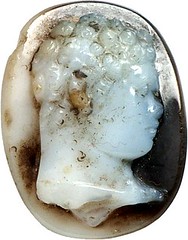
((885 – Cameo. Layered agate, 1.8 x 1.4 x 0.6cm. Bust of juvenile Hercules or Caracalla, lion skin (?) around neck. Late 2nd / early 3rd cent. A. D. Estimate: 1,450 euros)) A fine selection of a number of gems, objects of ancient mobiliary art objects like fibulae and clay lamps as well as numismatic literature conclude the offer. The fully illustrated catalog can be ordered against a protective fee of 12.50 € at Paul-Francis Jacquier, Honsellstraße 8, D-77694 Kehl am Rhein, phone: 07851 / 1217, email: office@coinsjacquier.com To do Live Bidding, please register in time at www.coinsjacquier.com.
You can view the auction catalog on the internet at
www.sixbid.com/browse.html?auction=887
The Numismatic Bibliomania Society is a non-profit organization promoting numismatic literature. See our web site at coinbooks.org. To submit items for publication in The E-Sylum, write to the Editor at this address: whomren@gmail.com To subscribe go to: https://my.binhost.com/lists/listinfo/esylum All Rights Reserved. NBS Home Page Contact the NBS webmaster 
|